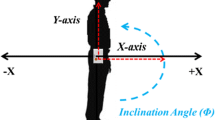Abstract
Smart phone is becoming an ideal platform for continuous and transparent sensing with lots of built-in sensors. Activity recognition on smart phones is still a challenge due to the constraints of resources, such as battery lifetime, computational workload. Keeping in view the demand of low energy activity recognition for mobile devices, we propose an energy-efficient method to recognize user activities based on a single low resolution tri-axial accelerometer in smart phones. This paper presents a hierarchical recognition scheme with variable step size, which reduces the cost of time consuming frequency domain features for low energy consumption and adjusts the size of sliding window to improve the recognition accuracy. Experimental results demonstrate the effectiveness of the proposed algorithm with more than 85% recognition accuracy for 11 activities and 3.2 hours extended battery life for mobile phones.
Access this chapter
Tax calculation will be finalised at checkout
Purchases are for personal use only
Preview
Unable to display preview. Download preview PDF.
Similar content being viewed by others
References
Kawahara, Y., Ryu, N., Asami, T.: Monitoring Daily Energy Expenditure Using a 3-Axis Accelerometer with a Low-Power Microprocessor. International Journal on Human-Computer Interaction 1(5), 145–154 (2009)
Kim, E., Helal, S., Cook, D.: Human Activity Recognition and Pattern Discovery. IEEE Pervasive Computing 9(1), 48–53 (2010)
Gu, T., Wang, L., Wu, Z., Tao, X., Lu, J.: A Pattern Mining Approach to Sensor-Based Human Activity Recognition. IEEE Transactions on Knowledge and Data Engineering 23(9), 1359–1372 (2011)
Nijholt, A., Zwiers, J., Peciva, J.: Mixed reality participants in smart meeting rooms and smart home environments. Personal and Ubiquitous Computing 13(1), 85–94 (2009)
Bouten, C., Koekkoek, K., Verduin, M., Kodde, R., Janssen, J.D.: A triaxial accelerometer and portable data processing unit for the assessment of daily physical activity. IEEE Transactions on Biomedical Engineering 44(3), 136–147 (1997)
Khan, A.M., Lee, Y., Lee, S.Y., Kim, T.: A triaxial accelerometer-based physical-activity recognition via augmented-signal features and a hierarchical recognizer. IEEE Transactions on Information Technology in Biomedicine 14(5), 1166–1172 (2010)
Kwapisz, J.R., Weiss, G.M., Moore, S.A.: Activity Recognition using Cell phone Accelerometers. ACM SIGKDD Explorations 12(2), 74–82 (2010)
Maurer, U., Smailagic, A., Siewiorek, D.P., Deisher, M.: Activity Recognition and Monitoring Using Multiple Sensors on Different Body Positions. In: Proc. of International Workshop on Wearable and Implantable Body Sensor Networks, pp. 113–116 (2006)
Győrbíró, N., Fábián, Á., Hományi, G.: An Activity Recognition System for Mobile Phones. Mobile Networks and Applications 14(1), 82–91 (2009)
Mannini, A., Sabatini, A.M.: Machine Learning Methods for classifying Human physical activity from on-body accelerometers. Sensor 10(2), 1154–1175 (2010)
Krishnan, N.C., Juillard, C., Colbry, D.: Recognition of hand movements using wearable accelerometers. Journal of Ambient Intelligence and Smart Environments 1, 143–155 (2009)
Ruch, N., Rumo, M., Mader, U.: Recognition of activities in children by two uniaxial accelerometers in free-living conditions. European Journal of Applied Physiology 111(8), 1917–1927 (2011)
Lee, M., Khan, A.M., Kim, J., Cho, Y., Kim, T.: A Single Tri-axial Accelerometer-based Real-time Personal Life Log System Capable of Activity Classification and Exercise Information Generation. In: Proc. of 2010 Annual International Conference of the IEEE Engineering in Medicine and Biology Society, pp. 1390–1393 (2010)
He, Z., Liu, Z., Jin, L., Zhen, L., Huang, J.: Light weightness Feature – A Novel Feature for single Tri-axial accelerometer based Activity Recognition. In: Proc. of 19th International Conference on Pattern Recognition, pp. 1–4 (2008)
Ravi, N., Dander, N., Mysore, P., Littman, M.L.: Activity Recognition from Accelerometer Data. In: Proc. of the 20th National Conference on Artificial Intelligence and the 17th Innovative Applications of Artificial Intelligence Conference, pp. 1541–1546 (2005)
Wang, Y., Lin, J., Annavaram, M., Quinn, J.A., Jason, H., Bhaskar, K., Sadeh, N.: A Framework of Energy Efficient Mobile Sensing for Automatic User State Recognition. In: Proc. of the 7th ACM International Conference on Mobile Systems, Applications, and Services, pp. 179–192 (2009)
Zappi, P., Lombriser, C., Stiefmeier, T., Farella, E., Roggen, D., Benini, L., Tröster, G.: Activity Recognition from On-Body Sensors: Accuracy-Power Trade-Off by Dynamic Sensor Selection. In: Verdone, R. (ed.) EWSN 2008. LNCS, vol. 4913, pp. 17–33. Springer, Heidelberg (2008)
Li, X., Cao, H., Chen, E., Tian, J.: Learning to Infer the Status of Heavy-Duty Sensors for Energy Efficient Context-Sensing. ACM Transactions on Intelligent Systems and Technology (unpublished)
Bao, L., Intille, S.S.: Activity Recognition from User-Annotated Acceleration Data. In: Ferscha, A., Mattern, F. (eds.) PERVASIVE 2004. LNCS, vol. 3001, pp. 1–17. Springer, Heidelberg (2004)
Author information
Authors and Affiliations
Editor information
Editors and Affiliations
Rights and permissions
Copyright information
© 2012 Springer-Verlag Berlin Heidelberg
About this paper
Cite this paper
Liang, Y., Zhou, X., Yu, Z., Guo, B., Yang, Y. (2012). Energy Efficient Activity Recognition Based on Low Resolution Accelerometer in Smart Phones. In: Li, R., Cao, J., Bourgeois, J. (eds) Advances in Grid and Pervasive Computing. GPC 2012. Lecture Notes in Computer Science, vol 7296. Springer, Berlin, Heidelberg. https://doi.org/10.1007/978-3-642-30767-6_11
Download citation
DOI: https://doi.org/10.1007/978-3-642-30767-6_11
Publisher Name: Springer, Berlin, Heidelberg
Print ISBN: 978-3-642-30766-9
Online ISBN: 978-3-642-30767-6
eBook Packages: Computer ScienceComputer Science (R0)




